CADworks3D is a Canadian manufacturer of 3D printers and developer of 3D materials. They have developed a DLP 3D Printer designed specifically for microfluidics applications, the ProFluidics 285. This revolutionary machine is changing the way researchers view microfluidic device manufacturing and offers an alternative fabrication technique to conventional techniques which are notoriously time-consuming, expensive and labor-intensive.
ProFluidics’ 285D allows for workflows to be streamlined and simple. The ProFluidics 285D is a multipurpose machine that can print a variety microfluidic structures and devices. These include clear devices with encapsulated elements, master moulds for PDMS, or biocompatible devices. Together with CADworks3D’s line of 3D material, researchers can reliably produce 100µm channels, and smaller depending on the device’s design.
“CADworks3D’s ultimate goal is to empower microfluidic researchers by providing them with an accessible 3D printing system that is affordable, easy-to-adopt, and versatile – all without sacrificing high-resolution print quality.”

What is Standard DLP 3D printing?
Digital Light Processing (DLP), also known as resin 3D Printing or vat polymerization, is one of most popular technologies that converts digital computer-aided designs (CAD) into useful 3D objects. This technology relies on a digital projector which beams UV-light onto a set of micromirrors, called a Digital Micromirror Device. These mirrors reflect UV light on a layer photosensitive resin, causing it to cure into the shape of an object being printed. It is repeated until an object is complete. (See Figure B on the Left Side).
Similar to a CT slice, a CAD file is divided into layers. Each layer is divided into a grid pixel, where each pixel corresponds to a single mirror in the DMD. The projector activates mirrors that correspond to the pixels needed to create the CAD files while printing the layer. When the mirrors activated, the UV light is reflected onto the resin liquid and it cures precisely on the pixels. Deactivating the mirrors will not cause them to shine and leave those resin areas uncured. (See Figure B, Right Side) The projected pixel size is expressed in micrometers (µm) and coincides with the XY resolution listed on a printer’s technical specifications.
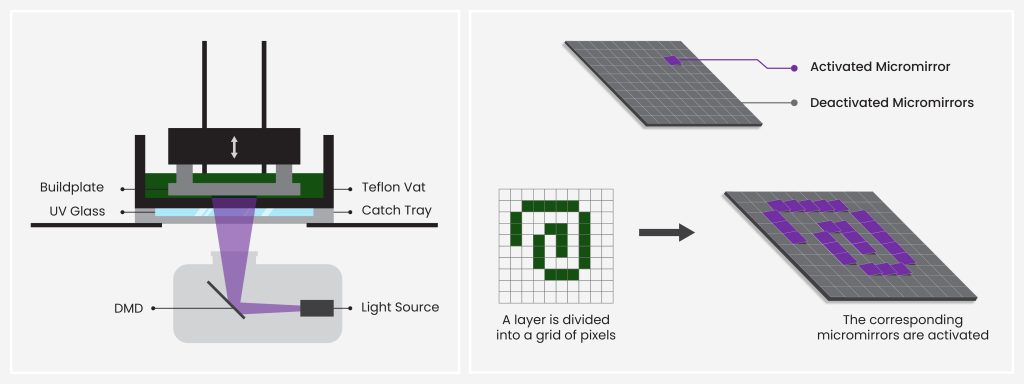
The ProFluidics DLP 285D is superior to standard DLP 3D printing:
Print Smooth Curves & Shapes
What happens when pixels are bisected by parts of a CAD file? DLP printers standard will determine how much design is covered by a pixel, and then use a binary rounded function to activate or deactivate that pixel. The device will have a surface with a visible checkered pattern and a stepped curve (See Figure C on the Left Side). The device often deviates from the original CAD.
ProFluidics 285D’s dynamic pixel advantage addresses this problem. Delivering a dynamic XY resolution of 28.5µm, the ProFluidics 285D offers significant improvements in accurately resolving design features – even those that bisect pixels. The printed devices are very similar to the original design and cube patterns or noise are minimal compared with other platforms. (See Figure C on the Right Side). This technology allows the ProFluidics 285D to print intricate geometries, including 180-degree turns and complex serpentine channels.
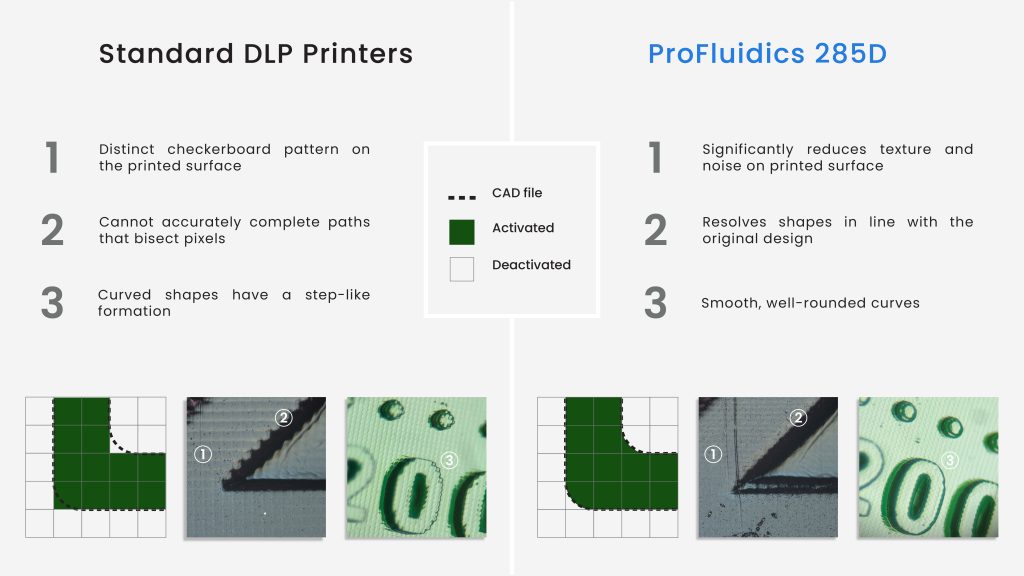
Clear Encapsulated Devices
The ProFluidics 285D is capable of producing different types of microfluidics devices.
The viability and scale of these encapsulated channels are crucial aspects of these devices, and with CADworks3D’s Clear Microfluidics Resin, the ProFluidics 285D excels. Devices can be fabricated in just one print job without assembling multiple parts, and encapsulated channels printed in the XY can be as fine as 80μm. Researchers can also design more innovative designs by incorporating different Z heights. For example, helix coils.
Post-processing can be done quickly and easily. Depending on the device’s height, the entire process of printing a ready-to-use device can be completed in just over an hour. It is not necessary to polish or coat the surface in order to achieve optical transparancy. This saves time and eliminates many tedious steps that are required with other methods. Clear Microfluidics Resin does not react with fluorescent lighting and is therefore suitable for imaging, microscopy, and other applications.
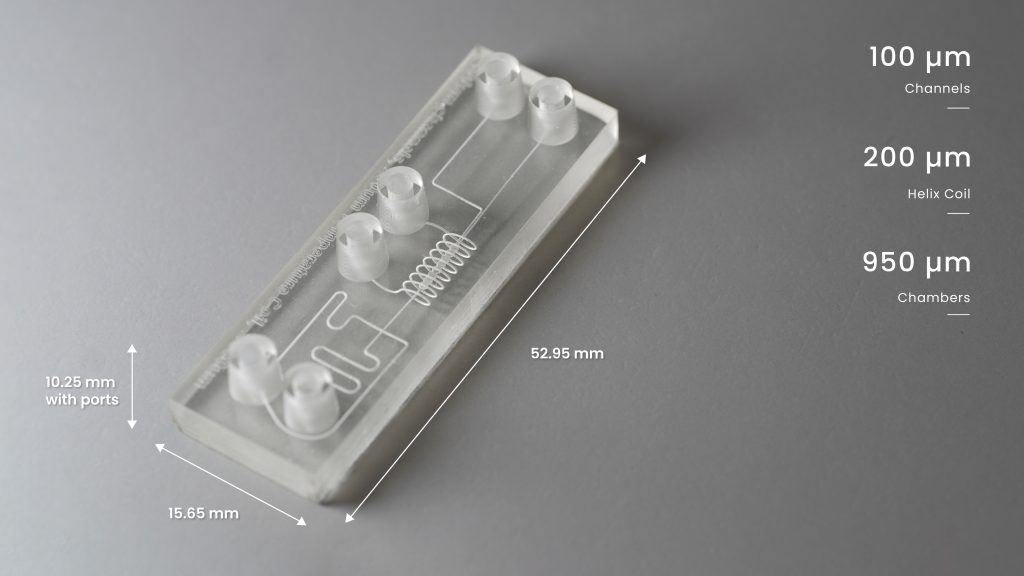
Application 2: Master Molds For PDMS Devices
When using conventional techniques such as photolithography, it is costly, time-consuming, difficult, and tedious to fabricate master molds. The ProFluidics 285D allows the creation of master moulds to be moved from the cleanroom and brought directly to the bench. This significantly accelerates the process. Researchers are able to 3D-print, clean and cure a mold master in a matter of hours. A PDMS device is cast within a day and ready to be bonded to a surface.
With CADworks3D’s Master Mold for PDMS Device Resin, you can print molds with channel widths as small as 50um. The printed molds demonstrate exceptional detail and smoothness with an average measured Ra value of 0.18µm. These printed masters are durable and can withstand temperatures required to cure PDMS and cast it in an oven. They can also be used to repeatedly cast hundreds of PDMS products from one master.
Photopolymer resins are formulated to eliminate the need for release agents, coatings or other pre-treatments for a clean PDMS casting. The printed master also does not leak any chemicals on to the casted PDMS. This ensures that the resulting PDMS products retain their biocompatible qualities.
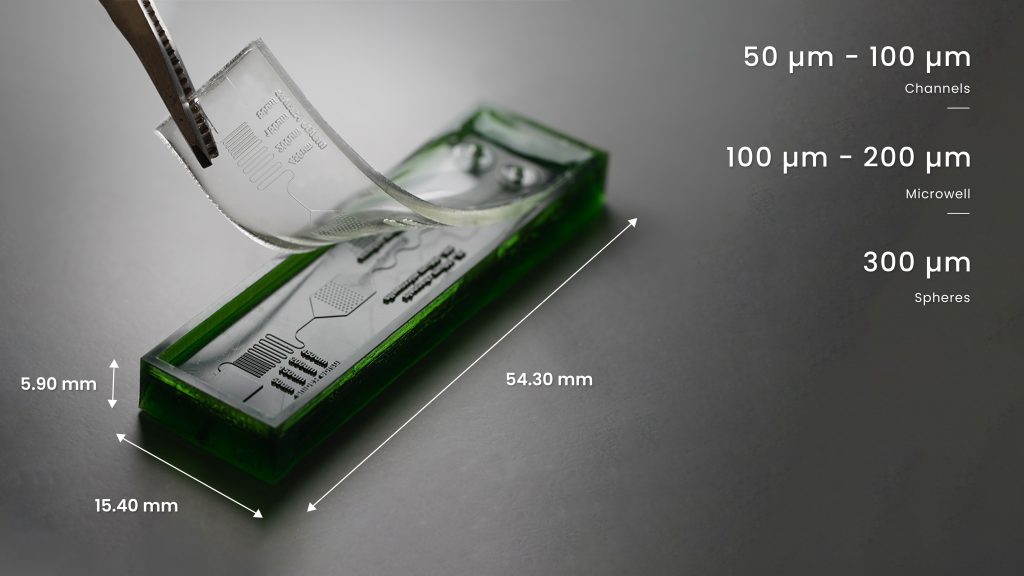
Application 3: Biocompatible Devices & Structures
The ProFluidics285D is a biocompatible device that operates on a system of open materials, which allows users to print using 3rd-party materials. The ProFluidics 285D is equipped with a projector with a 385nm light source. It can therefore print with biocompatible resins for bioscaffolds.
The ability to print a staggered grid is a unique feature of 3D printed bioscaffolds (See Figure G). This randomization allows cells to grow on the bias, resulting in a more uniform distribution of growth. Using the Detax Freeprint Ortho Resin as an example, the ProFluidics 285D is able to print bioscaffolds in just over an hour with struts as fine as 100µm and spacings that range between 700µm-1400µm.
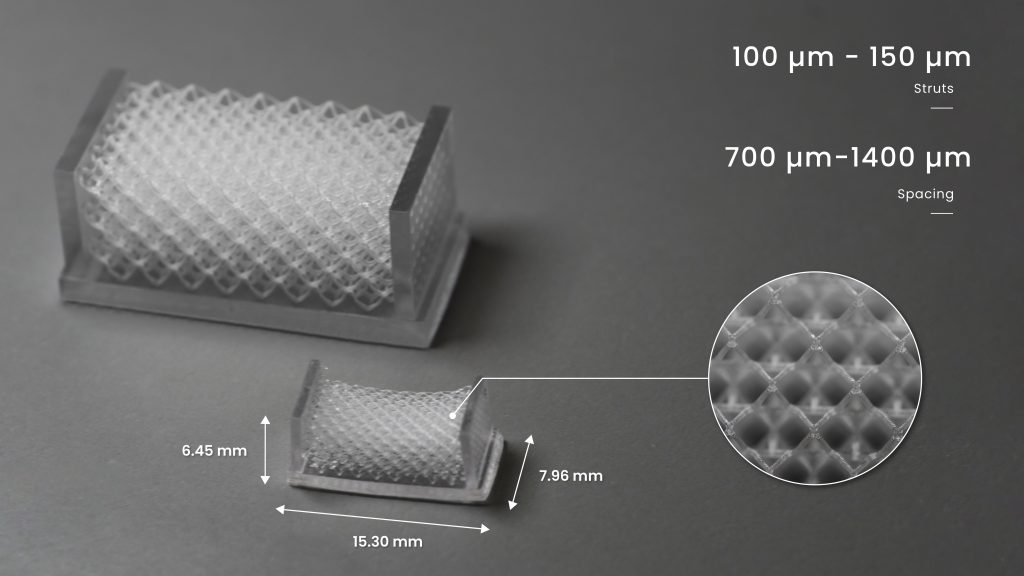
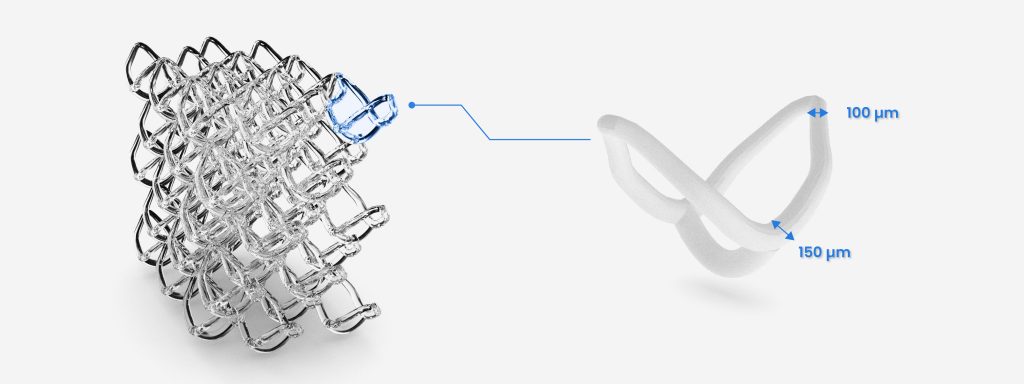
Microfluidics Research: Made to Empower You
The existing 3D marketplace typically offers solutions for microfluidics that are repurposed from other industries and as a result there is often a gap or a complete mismatch between a researcher’s needs and a printer’s capabilities. Many existing platforms are unable to produce microfluidic features with a size of less than 100 microns.
CADworks3D’s ProFluidics 285D and materials have been formulated solely with microfluidic applications in mind. Together, they offer a complete package to researchers, meeting the demand for finer printed features with minimum channel sizes of 80µm and 50µm for encapsulated and open channels, respectively. It enables new, innovative workflows which save time, money and labor costs for researchers. It becomes possible to produce three to five devices in just a few hours, where at 5g per device, the cost is approximately US$2.05 – US$2.55. Comparing the costs of traditional fabrication or outsourcing fabrication to a third-party 3D printer service, it is clear that working with an in-house 3D platform offers significant benefits.
The ProFluidics285D is shown in the featured image. Photo via CADworks3D.